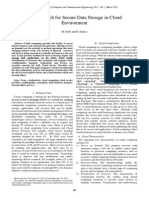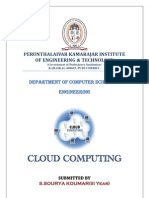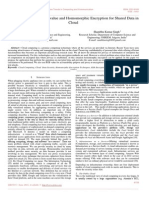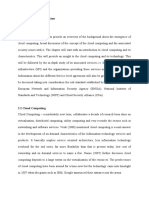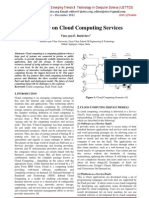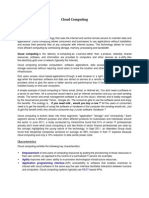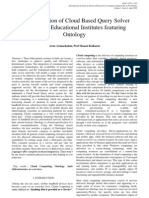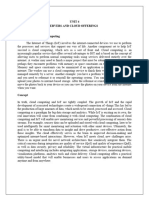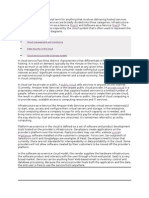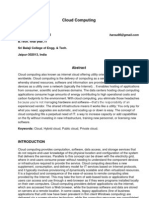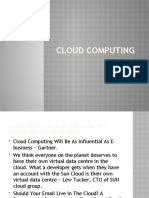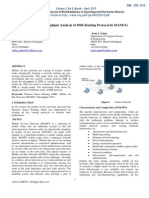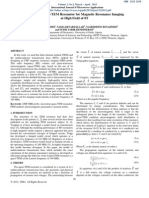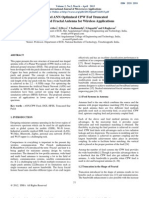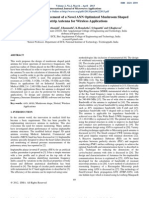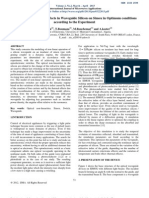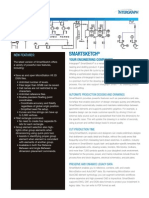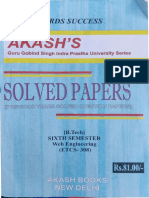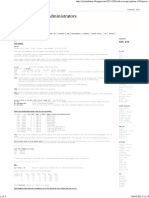I Jsa It 01222013
I Jsa It 01222013
Uploaded by
warse1Copyright:
Available Formats
I Jsa It 01222013
I Jsa It 01222013
Uploaded by
warse1Original Title
Copyright
Available Formats
Share this document
Did you find this document useful?
Is this content inappropriate?
Copyright:
Available Formats
I Jsa It 01222013
I Jsa It 01222013
Uploaded by
warse1Copyright:
Available Formats
U.S Pandey et al.
, International Journal of Science and Advanced Information Technology, 2 (2), March - April 2013, 08-16
ISSN 2278-3083
Volume 2, No.2, March April 2013 International Journal of Science and Applied Information Technology Available Online at http://warse.org/pdfs/ijsait01222013.pdf
GOOGLE APP ENGINE AND PERFORMANCE OF THE WEB APPLICATION
Dr. U.S Pandey Associate Professor, School of Open Learning Delhi University, Delhi, India Email:uspandey1@gmail.com, Anjali Jain Mewar University, Gangrar, Chittorgarh(Rajasthan),India Email:anjalijain81@gmail.com
ABSTRACT Cloud computing is an internet-based model of computing, where the shared information, software and resources are provided to computers and other devices upon demand. Cloud computing provides enormous business opportunity. Cloud computing could dramatically lower the need for upfront investments in it and ongoing maintenance. User pay only for the time, resources, and capacities he uses while scaling up to accommodate the changing business needs. There are various cloud computing platforms available. One very interesting cloud computing platform is Google App Engine (GAE). Cloud computing has emerged recently that focuses on reduction of expenses on resources and thus the application can be developed in a pay as you go manner. Then the web applications can be uploaded to the cloud and maintained without any issues on the enterprise side. Cloud computing on the other hand has emerged as a solution to cut down the enterprises expenditures but there is a limited literature about how to use it. Cloud computing refers to applications and services offered over the internet. These services are offered from data centres all over the world, which collectively are referred to as the "cloud." this metaphor represents the intangible, yet universal nature of the internet. [2] Cloud computing is a model for enabling on-demand network access in order to share computing resources such as network bandwidth, storage, applications, etc , that is able to be rapidly scalable with minimal service provider management [3]. Gartner defines cloud computing as a style of computing in which scalable and elastic IT-enabled capabilities are delivered as a service using Internet technologies. In cloud computing, the word cloud is used as a metaphor for "the Internet," so the phrase cloud computing means "a type of Internet-based computing," where different services -- such as servers, storage and applications -- are delivered to an organization's computers and devices through the Internet.[17]
This article focuses on how to move social applications into the cloud and on the evaluation of their performance. The study shows Cloud computing offers the services on demand and are how to implement a social networking application using GAE cloud delivered economically. Any user with an internet connection can with limited code and evaluates the scalability of the applications. access the cloud and the services it provides. Since these services are often connected, users can share information between multiple Key words: Apache JMeter, Cloud computing, Goggle App Engine, systems and with other users. Traditionally data storage devices and Social networking services. computer set up need to be at the same location, but cloud allows users to access to services any time, on any device, anywhere in the 1. INTRODUCTION world. Cloud Computing allows the users to upload and maintain their data, application software on the remote servers which can be According to NIST Cloud computing is a model for enabling easily accessible anywhere, anytime with the help of internet. With ubiquitous, convenient, on-demand network access to a shared pool the help of Cloud Computing user doesnt have to install of configurable computing resources (e.g., networks, servers, applications. This helps small and middle size entrepreneurs to set up storage, applications, and services) that can be rapidly provisioned their businesses when they are not able to indulge much amount of and released with minimal management effort or service provider hardware and storage space. It also provides more efficient interaction . computing by centralizing data storage, processing and bandwidth. As consumers, we now expect that the information should be Investopedia explains 'cloud computing'-cloud computing is so available us in real time, and business applications in the cloud are named because the information being accessed is found in the heading in that direction as well. [4] "clouds", and does not require a user to be in a specific place to gain access to it. Companies may find that cloud computing allows them According to analyst outfit IDC, "cloud services" are the to reduce the cost of information management, since they are not consumer and business products, services and solutions that people required to own their own servers and can use capacity leased from access and consume in real-time over the Internet. Cloud services are third parties. Additionally, the cloud-like structure allows companies typically easy to set up, with the customer not having to worry about to upgrade software more quickly. [1] the complications of implementation. The services are also based on 8
U.S Pandey et al., International Journal of Science and Advanced Information Technology, 2 (2), March - April 2013, 08-16
a "pay-as-you-go" or subscription model to make them more 3. DEPLOYMENT MODELS OF CLOUD COMPUTING affordable for various business types and sizes. NIST specified the following deployment models of cloud computing:In cloud computing there is no direct connection to a server, instead this is a model which delivers the information technology Private cloud-The cloud services and resources are retrieved from the internet through webinfrastructure is provisioned for based tools and applications. Cloud computing allows to work exclusive use by a single remotely. Here data and applications are stored on the servers. organization comprising multiple consumers (e.g., business units). It According to Roger Jennings 2013 will bring continued may be owned, managed, and growth to all primary cloud services segments; SaaS, PaaS and IaaS operated by the organization, a combined will grow at a compounded annual growth rate (CAGR) of third party, or some combination of them, and it may exist on or off about 25%. PaaS and IaaS alone will grow from $964 million in premises. 2010 to $3.9 billion in 2013, a CAGR of 60%, according to the 451 group. Platform-agnostic IaaS will continue to amass the lion's share Community cloud-The cloud infrastructure is provisioned for of revenues, but provider-specific PaaS will gain a larger split of the exclusive use by a specific community of consumers from pie as developers become more comfortable making the transition organizations that have shared concerns (e.g., mission, security from on-premises applications. requirements, policy, and compliance considerations). It may be owned, managed, and operated by one or more of the organizations Gartner inc. Predicts the market for public cloud computing in the community, a third party, or some combination of them, and it services will swell to $207 billion by 2016, up from $109 billion may exist on or off premises. today. It also predicts that in 2017, the chief marketing officer will Public cloud-The cloud infrastructure is provisioned for open use by spend more on it. the general public .It may be owned, managed, and operated by a business, academic, or government organization, or some The economist-IBM report [5] provides some shining examples combination of them. It exists on the premises of the cloud provider. of companies that are employing cloud computing to not only cut it Hybrid cloud- The cloud infrastructure is a composition of two or costs, but also play a role in disruptive innovation: more distinct cloud infrastructures (private, community, or public) 1. Through cloud cost flexibility, online marketplace gains that remain unique entities, but are bound together by standardized access to more powerful analytics online. or proprietary technology that enables data and application 2. Greater business scalability enables online video retailer to portability(e.g., cloud bursting for load balancing between clouds). meet spikes in demand 3. Greater market adaptability provides online entertainment 4. BENEFITS OF CLOUD COMPUTING [6] platform the ability to reach any type of customer device. 4. Masked complexity enables access to services, no matter Proven web-services integration. Cloud computing how intricate the technology theyre built on. technology is far easier to integrate with your existing applications - whether traditional or virtual. According to the Cloud Computing Manifesto, The key 100% virtual infrastructure - no software, no onsite characteristics of the cloud are the ability to scale and provision installation. Cloud computing slashes the capital costs of computing power dynamically in a cost efficient way and the ability getting up and running. of the consumer to make the most of that power without having to Faster and lower-risk deployment. With cloud server manage the underlying complexity of the technology [18]. technology you can save your business years and millions of dollars. 2. CHARACTERISTICS OF CLOUD COMPUTING [19] Support for deep customisations. Cloud computing in India allows deep customisation and application It is infinitely scalable. configuration. Cloud computing technology is well suited to It provides one or more of an infrastructure for platforms, a application development, ideal for organisations constant platform for applications or applications themselves. evolution. Clouds can be used for every purpose from disaster Empowered business users. Cloud computing technology recovery/business continuity through to a fully outsourced allows instant, point-and-click customisation and report ICT service for an organisation. generation for business users. So it doesn't have to spend Currently the major cloud providers had already invested in half its time making minor amendments and running large scale infrastructure and now offer a cloud service to reports. exploit it. Automatic upgrades with no downside. Cloud computing As a consequence the cloud offerings are heterogeneous and infrastructures allow upgrading to the latest-and-greatest without agreed interfaces cloud providers essentially version of an application without spending precious time provide datacentres for outsourcing. and resources rebuilding customisations and integrations. There are concerns over security if a business places its You no longer have to choose between upgrading and valuable knowledge, information and data on an external preserving all your hard work, because all customisations service. and integrations are automatically preserved - during and after an upgrade.
9 @ 2012, IJSAIT All Rights Reserved
U.S Pandey et al., International Journal of Science and Advanced Information Technology, 2 (2), March - April 2013, 08-16
5.
DISADVANTAGES OF CLOUD COMPUTING [7] Cost o
Despite the appearance of cheaper software within the cloud, customers should be aware of what they are actually getting before they buy. Will the software provide you with all of the features needed? How important are these features to the company?
These runtime environments are built to ensure that your application runs quickly, securely, and without interference from other apps on the system. With App Engine, you only pay for what you use. There are no set-up costs and no recurring fees. The resources your application uses, such as storage and bandwidth, are measured by the gigabyte, and billed at competitive rates. You control the maximum amounts of resources your app can consume, so it always stays within your budget. App Engine costs nothing to get started. All applications can use up to 1 GB of storage and enough CPU and bandwidth to support an efficient app serving 6. SOCIAL NETWORKING around 5 million page views a month, absolutely free. When you SERVICES enable billing for your application, your free limits are raised, and A social networking service is an online service, platform, or you only pay for resources you use above the free levels. [11] site that focuses on facilitating the building of social networks or Google App Engine makes it easy to build an application that social relations among people who, for example, share interests, runs reliably, even under heavy load and with large amounts of data. activities, backgrounds, or real-life connections. A social network service consists of a representation of each user (often a profile), App Engine includes the following features [12]: his/her social links, and a variety of additional services. Most social Dynamic web serving, with full support for common web network services are web-based and provide means for users to technologies. interact over the internet, such as E-mail and instant messaging. Persistent storage with queries, sorting and transactions. Online community services are sometimes considered as a social Automatic scaling and load balancing. network service, though in a broader sense, social network service usually means an individual-centred service whereas online APIs for authenticating users and sending email using community services are group-centred. Social networking sites allow Google accounts. users to share ideas, activities, events, and interests within their A fully featured local development environment that individual networks. [8] simulates Google App Engine on your computer Task queues for performing work outside of the scope of a Google App Engine was released in April 2008, is a platform for web request. building, hosting and scaling web applications using Google's Scheduled tasks for triggering events at specified times and infrastructure. It allows a developer to build and test web regular intervals. applications without the worry of maintaining servers, and so forth. It's pretty much a plug and plays type of solution, just upload your 8. APACHE JMETER application, and it's ready to serve your users. A lot of these applications are very raw and are just test beds for the developers. I developed a social networking website using Python on There are quite a few that are useful and have some potential. This Google App Engine. After developing this web application is tested post highlights 15 of them. [16] under different workloads. I used Apache JMeter to run the tests .The Apache JMeter 7. GOOGLE APP ENGINE desktop application is open source software, a 100% pure Java application designed to load test functional behaviour and measure App engine is Google's cloud-based performance. It was originally designed for testing web applications platform for hosting web applications written but has since expanded to other test functions. Apache JMeter may using Java, Python or an experimental be used to test performance both on static and dynamic resources 10
Security o Cloud computing is Internet computing. This means that the information is passing through an unsecure network (the Internet) and the information be transmitted should be monitored and regulated accordingly. However, established and reputable cloud service providers are aware of this concern and offer sophisticated data security systems to combat this potential problem. Internet Connectivity o Cloud services do require internet connectivity. No internet connectivity = No cloud services. This issue can be partially remedied by a stable and reputable service provider. However, even the best internet providers will experience down time. Technical Issues o Even the best cloud service provider, regardless of how stringent their maintenance standards, will occasionally experience service outages and technical issues.
implementation of the Go programming language-stated by Mikael Rickns[9]. The ability to host applications in Europe was first announced in June, but was then only offered to users with a so-called premier account, which cost $500 per month. Google is now changing that to include all paying users, the company said in a blog in 2012. Google App Engine allows running web applications on Google's infrastructure. App Engine applications are easy to build, easy to maintain, and easy to scale as your traffic and data storage needs grow. With App Engine, there are no servers to maintain: you just upload your application, and it's ready to serve your users. You can serve your app from your own domain name using Google apps. Or, you can serve your app using a free name on the appspot.com domain. You can share your application with the world, or limit access to members of your organization. [10] Applications can be developed in several programming languages like Java, Python in Google App Engine. Google App Engine provides Java, Python and Go runtime environments and their corresponding libraries to compile and run the respective codes.
U.S Pandey et al., International Journal of Science and Advanced Information Technology, 2 (2), March - April 2013, 08-16
(files, Servlets, Perl scripts, Java objects, data bases and queries, ftp servers and more). It can be used to simulate a heavy load on a server, network or object to test its strength or to analyze overall performance under different load types. You can use it to make a graphical analysis of performance or to test your server/script/object behaviour under heavy concurrent load. [13] It is used to test web applications for many server types including web requests (http, https). The experiments are conducted on a machine with the following configuration 2.40 GHZ Processor, 4.00 GB RAM, 100MBPS network card running over a 400MBPS Ethernet hub. The operating system is Microsoft Windows 7. The language used is Python with the GAE runtime. The evaluation for testing the Python services is to test the performance of the applications under different workloads. The attributes like verification, validation that define the performance of the application are scalability, reliability, and resource usage which demonstrate whether a system meets performance criteria. The load tests are modelled to simulate the expected number of users accessing the website concurrently. The stress testing is done to test the applications performance beyond normal users to determine the stability of the application, and break the application by overwhelming its resources [14]. For evaluating the performance of the applications developed with Python language different test beds are designed .Each test plan has to answer the following questions. a. What is the anticipated normal workload? b. What is the anticipated peak number of users? c. What is the good time to load test the application? This may sometimes crash the servers. d. What is testing intended to achieve? e. What is the sequence for the test? Functional (low volume of users)? Benchmark (average number of users)? Load test (maximum number of users)? Test destructively (the hard limit)?
watching videos, connecting to heavy audio and video files during the weekdays. This argument is true but the other networks which may be used for commercial or networking purposes may also be shaped by the network providers. Thus I conclude that these results are preliminary tests to check the scalability of the applications using Python language. The Apache JMeter can be used to test applications using the http or file transfer protocol (ftp) that can create the test plan based on the requirements. The JMeter has a web test plan that has two important components the test plan and a work bench. The test plan is a container to perform tests and the work bench is a container for any test to be performed or a portion of the test to be moved in to the test plan. The test plan has many sub components that can be added to it. When the test plan is right clicked a context menu appears to add the items to a test plan. The test bed for this experiment creates a load on servers and tests the performance of the services accordingly. A JMeter test creates a loop and a thread group. The loop simulates sequential requests to the server with a delay and a thread group is designed to simulate concurrent load. A load test using the JMeter test plan is to execute a sequence of operations. The important components of a test plan are thread group, controllers, assertions, listeners, timers, and configuration elements.
The thread group tells the users number of users to simulate, how often the user requests need to be sent, and how many requests they need to send. There are two types of controllers samplers and logical controllers. The samplers tell the JMeter to send a request and wait for the result. There are many samplers like http request, ftp request, and JDBC request etc. Logic controller enables to customize the logic of that JMeter follows. The assertion allows assert whether the results returned from the server are as according the results that we expected. The listeners provide the information that JMeter gathers when a test is run. The timers are used to pause between each web request that JMeter send to the server. By The test bed for testing the performance is based on load tests default the timer is off. The configuration element is used to add with varying workloads. The tests are performed for low, normal, or modify the requests and works with the samplers [15]. and high volume of users. The low and normal users are for 10, and 9. GOALS OF EVALUATION 50 users. The tests handle a peak load of 100 users concurrently for high volume of users. The tests were usually performed everyday in To evaluate the services by varying number of requests (10, the morning for n days (where n=5). The sequence of the tests is 50, and 100). used to handle 3 types of users functional users that handle less To perform repeated requests for n days and calculate the number of requests. The bench-mark for the users is to test for an difference between them. average of 50 users, and high flow of user requests of about 100. To calculate the time taken for each request individually for n days. The reasons to carry out the tests with a limit of 10, 50 and 100 users are based on the limited community of users who concurrently To calculate the time taken by the workflows. access the application. So the tests are conducted with those limited To test the performance of the services and workflows. values to mimic the real time user scenario. The applications are To study the scalability of services developed in Python and tested during Monday to Friday, morning 9am till 12 noon. The n Java. value is chosen as 5 because the tests are carried during the week days to see the performance of the GAE servers. 10. PHASE1: TEST BED FOR THE EXPERIMENTS IN PYTHON The tests are conducted using Apache JMeter as a preliminary evaluation mechanism even though it is believed that results may not The test bed for the services in Python is to evaluate the be 100% accurate due to minor Java timing errors. However, to test performance of the services over a certain time period. Initially each the reliability of the services and JMeter the tests are repeated for 5 service from both the languages is evaluated for a fixed period of n days. The reason for testing on weekdays is to check the days where (n=5). The services are evaluated for varying number of performance of the GAE services when there is traffic on the client requests with a fixed time difference between each request. network to simulate the requests on the web. The traffic is shaped due to requests on the network where there may be people be 11 @ 2012, IJSAIT All Rights Reserved
U.S Pandey et al., International Journal of Science and Advanced Information Technology, 2 (2), March - April 2013, 08-16
The phase 1 experimental test bed services developed in Python is Table 1 shows the services in Python and the graphs for the evaluated with increasing loads for 5 days. Each of the Python services in the same order as tabulated. measurements is recorded everyday in the morning 9 am till 12. The individual services are evaluated for 5 days for the best and 11. TEST BED worst performances with the workloads. The graphs for each of services are shown as in the sequence of the tabulated service names. The test bed is a simple http web request using Apache JMeter Also, for the tests on the services in Python, maximum, minimum, and defined in 4 steps. In step1 a thread group is created. The thread and average values for the time taken in milliseconds are calculated. group tells JMeter the number of users, how often the requests have Based on these values the delta is calculated. to be sent, and how many requests have to be sent. These properties The delta is the difference between maximum and minimum values. are explained by the fields number of threads (users), ramp-up period The graphs display variance values for each service in Python. (in seconds), and loop count. The field number of threads tells the Delta (a) =maximum (a)-minimum (a) JMeter the number of user simulations to be created, the ramp-up period in seconds indicates the time delay between each thread. For Where a is the column in the table. example if the number of threads is 6 and ramp-up period is 12 seconds then JMeter would send each request with a delay of 2 Results of the Python services based on the test plan all the seconds. The number of loops indicates number of times the requests services in Python are evaluated for different number loads of client have to be sent. requests (10, 50, 100) for n days where (n=5). The services in Python are evaluated for checking the best and worst performance among In step2, the tasks to be executed by the JMeter are defined. the five days with workloads and also for calculating the overall The thread group is selected and mouse right click option is chosen variance. to add a config element the http request defaults. The first part of the evaluation shows the performance of In step3 -a http request is defined by selecting the thread group the services for the workloads 10, 50, and 100 over a period of 5 and choosing a sampler with the name http request. In this page the days the graphs are recorded to calculate the best, worst, and average name, path, port, and method filled. The name, path and port time taken. The Figure 1, 2, and 3 show the time taken for login numbers are the same as default http request defaults but the service for 10, 50, and 100 workloads. In each graph the best and method is changed accordingly based on the type of request get or a worst time taken is observed as the best time defines the least time post. The lists of parameters are sent along with the request taken to process the workload. The worst time indicates the depending on the type of request. maximum time taken to process the workloads. In step4, the results of the test are viewed by adding a listener to the test plan. This element is used to store the results of the http request. The listener is added by selecting the test plan an adding a listener and adding an element to view results in a table. These results show the number of the requests, the thread group they belong to, time taken in milliseconds, the result of the request either success or failure. 12. RESULTS OF THE PHASE1 EXPERIMENTS Figure1:The performance of Python login service for workload (10).
This section discusses the results for the Python based services The Figure 1 shows the best performance as the least time taken to that are evaluated using the test bed in section. The services are process the workload of 10 requests. evaluated for varying number of client requests 10, 50, 100 for 5 days. The tables in the 1 show the services evaluated with varying client requests for Python language. Table 1: TABLE SHOWING THE LIST OF SERVICES EVALUATED IN PYTHON
Service name Login Main Account Poststories Comments Request type Post
Figure 2-the performance of Python login service for workload (50)
Get Get Post Post
Figure 2 shows the huge difference between the best performance and the worst performance. It is understood that the average performance for the services should be between the best and the worst performance graphs.
12 @ 2012, IJSAIT All Rights Reserved
U.S Pandey et al., International Journal of Science and Advanced Information Technology, 2 (2), March - April 2013, 08-16
Figure 3-the performance of Python login service for workload (100).
Figure 6-the performance of Python main service for workload (50).
The Figure 3 shows the performance graph for login service for The Figure 6 shows the performance graph for workload of 50 a workload of 100. In this graph the worst performance is indicated requests. by the highest time taken line. It is indicated as worst performance because of increase in workload, the time taken is also increased after 85 requests. The second part of the evaluation shows the variance of services. For each day the average time taken and its delta is calculated. As discussed earlier delta is calculated as the difference between maximum and minimum time recorded for a day. Similarly the averages and variances for the five days are taken and graph is drawn with the variances recorded from day 1 till day 5(from Figure 7-the performance of Python main service for Monday till Friday).the Figure 4 shows the time taken for login workload (100). services in Python based on the variances. The 3 different lines indicate the time taken for varying loads with the variance as The Figure 7 the performance graph for workload of 100 indicated. requests. It performs a get operation. In the Figure 5, the best and the worst performance doesnt overlap where as in Figure 6 and Figure 7 shows the overlap with a difference in time taken in each of the graphs .but for workload 50, best and worst graph shows a minimum difference between them. Figure 7 shows the time taken for worst performance line shows many fluctuations in a graph indicated with high volume of requests and maximum time taken. But the increased loads in both the Figures are balanced by the GAE servers that run the applications. The servers running the applications have balanced the load by sharing Figure 4-difference of the times taken (ms) using login service in the load with the server next to it thus a lowering line indicating the Python for workloads. decreasing load as shown. The Figure 4 shows the time taken for login service with different workloads. This service performs a post operation. With increased workload the value of delta also increases. For example for the workload 100 the delta value of time taken each day starting with day 1 is high and gradually decreases with the GAE balancing the load by running the application on many servers. When the load on the servers comes down, time taken for the requests also decreases as a result the graph shows rise and fall at certain locations. Similarly the performance graphs for the main service are shown in Figure 5 till Figure 8. The Figure 5 shows the performance graph for 10 requests.
Figure 8-difference of the times taken (ms) for main service in Python for workloads.
The Figure 8 shows the delta value for main service in Python for the workloads (10, 50, 100) in this figure it is observed that the delta value for processing 50 requests on a day 4 is more than the delta value for 100 requests. For 100 requests workload starting at day 3the delta value drops each day. This is due to GAE servers automatically balancing the load after a certain threshold where they distribute the load to the corresponding servers automatically. During this time the overall load on the available servers reduced and the time taken for processing the requests reduces. Using this approach there is a low failure of the requests and fewer the burdens Figure 5-the performance of Python main service for workload (10). on the server and ultimately time is reduced. Similarly Figure 9, 10, and 11 show the performances of the accounts service using workloads. 13 @ 2012, IJSAIT All Rights Reserved
U.S Pandey et al., International Journal of Science and Advanced Information Technology, 2 (2), March - April 2013, 08-16
Figure 9-the performance of Python accounts service for workload (10).
Figure 13-the performance of Python poststories service for workload (10). The Figure 13 shows the time taken for the requests in worst line is in the same shape as the time taken for the best. This indicates that they are taking constant time with the worst graph taking twice the time of best.
Figure 10-the performance of Python accounts service for workload.
Figure 14-the performance of Python poststories service for workload (50).
Figure 11-the performance of Python accounts service for workload (100). The Figure 12 shows the delta values for accounts service for all the workloads. For the account service, the peaks in the graphs Figure 15-the performance of Python poststories service for are observed similar to main service for the workloads 100 shown in workload (100). Figure 11.
Figure 16- difference of the times taken (ms) for poststories service in Python for workloads. Figure 12- difference of the times taken (ms) for accounts service in Python for workloads. The Figure 12 shows the delta values for the accounts service. The accounts service performs a get request operation. In this graph the delta values show increase in numbers with increase in workloads but gradually decrease as new servers are fired up to balance the loads. Similarly the graphs are recorded for poststories service. The poststories service performs post operation. The Figures 13 till 16 are the graphs for poststories service. Figure 17-the performance of Python comments service for 14 @ 2012, IJSAIT All Rights Reserved
U.S Pandey et al., International Journal of Science and Advanced Information Technology, 2 (2), March - April 2013, 08-16
workload (10)
may post a story using the poststories. Later the client may post a comment and change the account settings. These operations are defined in the workflow with the requests to different pages. Each page request is defined by the http request defaults and is associated with a http requests. The http requests defaults are having the default values based on which http request is processed. The simple logic controllers are used in the workflow to organize the samplers and other logical controllers. The simple logic controllers can be added by right clicking on the thread group. In the simple logic controllers http URL re-writing modifier is added where the session information is managed using the variable mentioned. The session id is cached if the option for the cache is checked and can be used for the other services. The results are recorded using the view results in a table which is added by right click option on the thread group. The Figure 21 shows the http URL re-writing modifier.
Figure 18-the performance of Python comments service for workload (50).
Figure 19-the performance of Python comments service for workload (100).
Figure 21- the http URL re-writing modifier and its properties. 15. RESULTS OF THE PHASE2 EXPERIMENTS This section discusses the results of the workflows using Python that are evaluated using JMeter. The workflows are evaluated Figure 20- difference of the times taken (ms) for comments service for workloads 10, 50, and 100. The workloads are recorded for n=5 in Python for workloads. days as to measure the performance of the GAE services during the days of a week. The workflow is defined as a sequence of service 13. PHASE2: WORKFLOWS FOR THE EXPERIMENTS navigation IN through an application. For the Python experiment the PYTHON workflow is in the order of the services mentioned in table 1. The first set of graphs shown in Figure 22 till Figure 44 show the best, The Python experiments aim at the performance of the services and worst performances of the workflow in Python for the workloads as a workflow. In these experiments a set of services are arranged as (10, 50, and 100). a workflow in such a way that users execute the requests as the path mentioned in the workflow. Each time specified number of requests are sent to the workflow for n days where n=5. The workflows are run every day in the morning for n days and graphs are recorded accordingly. 14. TEST BED The test bed for the experiments using Apache JMeter is explained in this section for the workflows. The workflows are designed separately for the experiments in Python. Figure 22-the performance of the Python workflow for workload (10).
The test bed has a sequence of 5 important steps. The test bed is same as the test bed for individual services but with additional simple controllers for session information. The test bed consists of the thread group which is used to define number of users, ramp-up time in seconds and the number of loops. The workflows are tested with workloads 10, 50, and 100. These workloads are tested on Figure 23-the performance of the Python workflow for everyday for n=5 days. Usually a client logs into the experiment workload (50). using login service which leads into the main service and the client 15 @ 2012, IJSAIT All Rights Reserved
U.S Pandey et al., International Journal of Science and Advanced Information Technology, 2 (2), March - April 2013, 08-16
Figure 24-the performance of the Python workflow for workload (100). For the workflows everyday minimum and maximum values are calculated. The workflows delta values are calculates as the difference between maximum and minimum.
Figure 25- difference of the times taken (ms) for the workflow in Python for workloads. 16. CONCLUSION A cloud computing platform enables applications to be hosted in an internet-accessible virtual environment that supplies the necessary hardware, software, network, and storage capacities and provides for security and reliability, removing much of the burden of purchasing and maintaining hardware and software in-house. In the cloud, you can develop, deploy, and manage applications as you have in the past and integrate these services to your on-premise applications. You pay only for the time, resources, and capacities you use while scaling up to accommodate the changing business needs.Typically, cloud environments provide low level abstractions of computation and storage. Computation and storage clouds act as building blocks where high level service clouds and mash-ups can be created. Storage clouds are often used to prolong the capabilities of storage-limited devices and provide transparent access to data from anywhere. In this article a web application was developed. The goals of the experiments are to investigate the GAE cloud architecture and its design principles and to develop the application with the basic services. Investigate accessing the applications using different clients. In experiments the MVC architecture guidelines are used. Experiments are conducted to evaluate the performance of the applications in order to test it with varying workloads for Python. For the purpose of testing a tool is used called Apache JMeter. Although the argument Apache JMeter is not a best tool for testing the scalability of the applications for concurrent client requests, it is one of the most popular one. The repeated experiments prove that the time taken for the services does not change rapidly. REFERENCES [1] http://www.investopedia.com/terms/c/cloudcomputing.asp#ixzz2lgpzxqtt [2] http://www.techterms.com/definition/cloud_computing
[3] A. Mell,t. Grance, The NIST definition of cloud computing, available at:Csrc.nist.gov/groups/sns/cloudcomputing/ cloud-def-v15.doc [4] http://www.salesforce.com/in/cloudcomputing/ [5] Joe Mckendrick, Shining examples of cloud computing in action, Feb 22, 2012, available at -http://www.forbes.com/sites/joemckendrick/2012/02/22/6-shining-examples-of-cloud-computingin-action/ [6] http://www.salesforce.com/in/cloudcomputing/ [7] http://www.opticfusion.net/blog/2013/02/01/advantages-anddisadvantages-of-cloud-computing/ [8] http://en.wikipedia.org/wiki/social_networking_service [9] Mikael Rickns, Google lets more users host App Engine applications in Europe December 14, 2012, available athttp://www.infoworld.com/d/cloud-computing/google-lets-moreusers-host-app-engine-applications-in-europe-209211 [10] https://developers.google.com/appengine/docs/whatisgoogleappengine [11] https://developers.google.com/appengine/docs/whatisgoogleappengine [12] https://developers.google.com/appengine/docs/whatisgoogleappengine [13] http://JMeter.Apache.org/ [14] Solanki, Jmeter: a tool for performance testing your webap, july 3rd 2010, available athttp://www.slideshare.net/amitkssolanki/JMeter-performancetesting-your-webapp [15] The Apache jakarta project, available athttp://jakarta.Apache.org/JMeter/usermanual/build-web-testplan.html [16] Mike Fruchter , Useful Google App Engine Applications, available at - http://blog.louisgray.com/2008/12/15-useful-googleapp-engine.html [17] http://www.webopedia.com/TERM/C/cloud_computing.html [18] The open cloud manifesto: A call to action for the worldwide cloud community, available athttp://opencloudmanifesto.org/opencloudmanifesto1. [19] http://cordis.europa.eu/fp7/ict/ssai/docs/cloud-report-final.pdf
16 @ 2012, IJSAIT All Rights Reserved
You might also like
- Business Implementation of Cloud ComputingDocument6 pagesBusiness Implementation of Cloud ComputingQuaid Johar SodawalaNo ratings yet
- Paper Presentation-Cloud ComputingDocument14 pagesPaper Presentation-Cloud Computingdeepakfct100% (4)
- Paper Presentation Cloud Computing PDFDocument14 pagesPaper Presentation Cloud Computing PDFamphoen2528100% (3)
- IrcDocument1 pageIrcKatrina Ross100% (1)
- Quickguide FG500.pdf 20111127213037Document11 pagesQuickguide FG500.pdf 20111127213037Marin AlexNo ratings yet
- Axioms of Cloud Computing: International Journal of Emerging Trends & Technology in Computer Science (IJETTCS)Document4 pagesAxioms of Cloud Computing: International Journal of Emerging Trends & Technology in Computer Science (IJETTCS)International Journal of Application or Innovation in Engineering & ManagementNo ratings yet
- Cloud Computing An OverviewDocument4 pagesCloud Computing An Overviewgurudatt.kulkarniNo ratings yet
- Iot R16 - Unit-5Document23 pagesIot R16 - Unit-5Surendra KumarNo ratings yet
- Compusoft, 2 (12), 404-409 PDFDocument6 pagesCompusoft, 2 (12), 404-409 PDFIjact EditorNo ratings yet
- An Approach For Secure Data Storage in Cloud Environment: M. Gobi and R. SrideviDocument4 pagesAn Approach For Secure Data Storage in Cloud Environment: M. Gobi and R. SrideviPriyankaNo ratings yet
- Ijet V4i3p33 PDFDocument10 pagesIjet V4i3p33 PDFInternational Journal of Engineering and TechniquesNo ratings yet
- Cloud Computing: Overview & Current Research Challenges: Mohsin NazirDocument9 pagesCloud Computing: Overview & Current Research Challenges: Mohsin NazirAbdullah AlwaqdyNo ratings yet
- Abdoo - On Graphtree PDFDocument9 pagesAbdoo - On Graphtree PDFAbdullah AlwaqdyNo ratings yet
- AccountingDocument5 pagesAccountingsoffian hj usopNo ratings yet
- Cloud Computing: Deployment Issues For The Enterprise SystemsDocument5 pagesCloud Computing: Deployment Issues For The Enterprise SystemsJournal of ComputingNo ratings yet
- Cloud ComputingDocument5 pagesCloud ComputingkevmatinNo ratings yet
- Cloud ComputingDocument5 pagesCloud ComputingAbdul OGNo ratings yet
- A Study of Infrastructure Clouds: International Journal of Computer Trends and Technology-volume3Issue1 - 2012Document5 pagesA Study of Infrastructure Clouds: International Journal of Computer Trends and Technology-volume3Issue1 - 2012surendiran123No ratings yet
- Study of Cloud ComputingDocument6 pagesStudy of Cloud ComputingInternational Organization of Scientific Research (IOSR)No ratings yet
- A Study of Cloud Computing MethodologyDocument5 pagesA Study of Cloud Computing MethodologyR Dharshini SreeNo ratings yet
- Load Balancing: Ranjan Kumar Mondal, Payel Ray, Debabrata SarddarDocument21 pagesLoad Balancing: Ranjan Kumar Mondal, Payel Ray, Debabrata Sarddarযা ইচ্ছে তাইNo ratings yet
- Osamah Shihab Al-NuaimiDocument7 pagesOsamah Shihab Al-NuaimiOmar AbooshNo ratings yet
- Is Cloud Computing Finally Beginning To Mature?Document4 pagesIs Cloud Computing Finally Beginning To Mature?Hengky CungNo ratings yet
- SurveyonCloudComputingwithCloudService Model PDFDocument5 pagesSurveyonCloudComputingwithCloudService Model PDFInternational Journal of Advanced and Innovative ResearchNo ratings yet
- A Scaffold For Performance Enhancement in Multitenant'S Applications For Geographical Data Centres in Private CloudDocument8 pagesA Scaffold For Performance Enhancement in Multitenant'S Applications For Geographical Data Centres in Private CloudInternational Journal of Application or Innovation in Engineering & ManagementNo ratings yet
- Cloud Computing: Perunthalaivar Kamarajar Institute of Engineering & TechnologyDocument15 pagesCloud Computing: Perunthalaivar Kamarajar Institute of Engineering & TechnologySaranya SelvaradjaneNo ratings yet
- The Privacy Implications of Cloud Computing in The Context of Software Reverse EngineeringDocument7 pagesThe Privacy Implications of Cloud Computing in The Context of Software Reverse EngineeringJournal of Computer Science and EngineeringNo ratings yet
- IJRAR2001696Document9 pagesIJRAR2001696arv83071No ratings yet
- Secure Cloud Using RGB Value and Homomorphic Encryption For Shared Data in CloudDocument4 pagesSecure Cloud Using RGB Value and Homomorphic Encryption For Shared Data in CloudEditor IJRITCCNo ratings yet
- Cloud Computing Apr'11Document2 pagesCloud Computing Apr'11Ramyakrishna DalapathiraoNo ratings yet
- Unit-5 (Iot Physical Servers and Cloud Offerings)Document11 pagesUnit-5 (Iot Physical Servers and Cloud Offerings)Paban YadavNo ratings yet
- Ijett V21P256Document8 pagesIjett V21P256Bharath KumarNo ratings yet
- Chapter 2 Literature ReviewDocument21 pagesChapter 2 Literature ReviewNazaf AzmiNo ratings yet
- "Business Models in Cloud Computing": Assignment-1Document22 pages"Business Models in Cloud Computing": Assignment-1Ajay KakkarNo ratings yet
- Iec College of Engineering & Technology, Gr. Noida: Cloud ComputingDocument21 pagesIec College of Engineering & Technology, Gr. Noida: Cloud ComputingTushar AgarwalNo ratings yet
- Ijettcs 2012 12 21 048Document4 pagesIjettcs 2012 12 21 048International Journal of Application or Innovation in Engineering & ManagementNo ratings yet
- Cloud Computing: Mini Project Work Entiled OnDocument24 pagesCloud Computing: Mini Project Work Entiled OnZeanav KhanNo ratings yet
- Cloud Security Feb 13Document7 pagesCloud Security Feb 13basualok@rediffmail.comNo ratings yet
- Cloud Computing: Ii HistoryDocument3 pagesCloud Computing: Ii HistoryDarshnik Deep100% (1)
- Job Scheduling in Cloud Computing: A Review of Selected TechniquesDocument5 pagesJob Scheduling in Cloud Computing: A Review of Selected TechniquesInternational Journal of Application or Innovation in Engineering & ManagementNo ratings yet
- Revised Assignment 2 Vaibhav Srivastava 64Document4 pagesRevised Assignment 2 Vaibhav Srivastava 64Vaibhav SrivastavaNo ratings yet
- Computer ScienceDocument15 pagesComputer ScienceDanielNo ratings yet
- An Assignment On Cloud ComputingDocument5 pagesAn Assignment On Cloud ComputingMD Monowar Ul IslamNo ratings yet
- Reliability of Cloud Computing Services: Anju Mishra & Dr. Viresh Sharma & Dr. Ashish PandeyDocument10 pagesReliability of Cloud Computing Services: Anju Mishra & Dr. Viresh Sharma & Dr. Ashish PandeyIOSRJEN : hard copy, certificates, Call for Papers 2013, publishing of journalNo ratings yet
- Cloud ComputingDocument27 pagesCloud ComputingNehal GuptaNo ratings yet
- 12 - Cloud Computing Basics PDFDocument5 pages12 - Cloud Computing Basics PDFpooja0100No ratings yet
- Cloud Computing A Review PaperDocument6 pagesCloud Computing A Review PaperIJRASETPublicationsNo ratings yet
- Cloud Computing: Cloud Computing Is A Technology That Uses The Internet and Central Remote Servers To Maintain Data andDocument11 pagesCloud Computing: Cloud Computing Is A Technology That Uses The Internet and Central Remote Servers To Maintain Data androhan7801No ratings yet
- Implementation of Cloud Based Query Solver System For Educational Institutes Featuring OntologyDocument7 pagesImplementation of Cloud Based Query Solver System For Educational Institutes Featuring OntologyIjarcet JournalNo ratings yet
- Unit 4Document11 pagesUnit 4reddyshadvaliniNo ratings yet
- Abstract-: Keywords: Applications, Architecture, Business Component of CloudDocument15 pagesAbstract-: Keywords: Applications, Architecture, Business Component of CloudKrishna BoreddyNo ratings yet
- Cloud Computing Is A General Term For Anything That Involves Delivering Hosted Services Over The InternetDocument14 pagesCloud Computing Is A General Term For Anything That Involves Delivering Hosted Services Over The InternetKh Aasim BashirNo ratings yet
- Cloud Computing Correctd VersionDocument9 pagesCloud Computing Correctd VersionHafsa JehangirNo ratings yet
- Harshvardhan Saini: Cloud ComputingDocument5 pagesHarshvardhan Saini: Cloud ComputingHarshvardhan SainiNo ratings yet
- X433 Data Comm Final ProjectDocument6 pagesX433 Data Comm Final ProjectJackie MicianoNo ratings yet
- Cloud Computing: Submitted By: Divya Khandelwal B.Tech (CSE) 7 Sem 0271352707Document31 pagesCloud Computing: Submitted By: Divya Khandelwal B.Tech (CSE) 7 Sem 0271352707divya25sepNo ratings yet
- Cloud ComputingDocument82 pagesCloud ComputingKartheeswari SaravananNo ratings yet
- Cloud Computing and Virtualization: Streamlining Your IT InfrastructureFrom EverandCloud Computing and Virtualization: Streamlining Your IT InfrastructureNo ratings yet
- Cloud computing: Moving IT out of the officeFrom EverandCloud computing: Moving IT out of the officeBCS, The Chartered Institute for ITNo ratings yet
- A Survey On Throughput Analysis of DSR Routing Protocol in ManetsDocument6 pagesA Survey On Throughput Analysis of DSR Routing Protocol in Manetswarse1No ratings yet
- Microstrip Quasi-TEM Resonator For Magnetic Resonance Imaging at High Field of 8TDocument5 pagesMicrostrip Quasi-TEM Resonator For Magnetic Resonance Imaging at High Field of 8Twarse1No ratings yet
- Design of Low Pass Filter Using Concentric Split-Ring DGS: Abhisar Khokhar, P.K. Singhal, Mahesh Kumar AghwariyaDocument4 pagesDesign of Low Pass Filter Using Concentric Split-Ring DGS: Abhisar Khokhar, P.K. Singhal, Mahesh Kumar Aghwariyawarse1No ratings yet
- Ijma 11222013Document3 pagesIjma 11222013warse1No ratings yet
- Characterization of A High-Power Erbium-Doped Fiber LaserDocument4 pagesCharacterization of A High-Power Erbium-Doped Fiber Laserwarse1No ratings yet
- Ijma 07222013Document8 pagesIjma 07222013warse1No ratings yet
- Ijma 04222013Document6 pagesIjma 04222013warse1No ratings yet
- Ijma 06222013Document8 pagesIjma 06222013warse1No ratings yet
- Ijma 05222013Document5 pagesIjma 05222013warse1No ratings yet
- Slot Loaded Microstrip Antenna For GPS, Wi-Fi, and Wimax Applications SurveyDocument6 pagesSlot Loaded Microstrip Antenna For GPS, Wi-Fi, and Wimax Applications Surveywarse1No ratings yet
- Modeling of Nonlinear Effects in Waveguide Silicon On Simox in Optimum Conditions According To The ExperimentDocument7 pagesModeling of Nonlinear Effects in Waveguide Silicon On Simox in Optimum Conditions According To The Experimentwarse1No ratings yet
- Ijiti 01222013Document6 pagesIjiti 01222013warse1No ratings yet
- I Ji Scs 02222013Document5 pagesI Ji Scs 02222013warse1No ratings yet
- A Simple and Original Design of Multi-Band Microstrip Patch Antenna For Wireless CommunicationDocument4 pagesA Simple and Original Design of Multi-Band Microstrip Patch Antenna For Wireless Communicationwarse1No ratings yet
- I Jac ST 01242013Document12 pagesI Jac ST 01242013warse1No ratings yet
- 3D Face Recognition Based On Deformation Invariant Image Using Symbolic LDADocument6 pages3D Face Recognition Based On Deformation Invariant Image Using Symbolic LDAwarse1No ratings yet
- Algan/Gan Hfet:: Nonlinearity Analysis With Nonlinear Source ResistanceDocument4 pagesAlgan/Gan Hfet:: Nonlinearity Analysis With Nonlinear Source Resistancewarse1No ratings yet
- A Knowledge Based System Towards Identifying Problems and Getting Instant Solutions About Our Personal VehiclesDocument6 pagesA Knowledge Based System Towards Identifying Problems and Getting Instant Solutions About Our Personal Vehicleswarse1No ratings yet
- Clustering Based Integration of Personal Information Using Weighted Fuzzy Local Information C-Means AlgorithmDocument4 pagesClustering Based Integration of Personal Information Using Weighted Fuzzy Local Information C-Means Algorithmwarse1No ratings yet
- A Review On Dynamic Manet On Demand Routing Protocol in ManetsDocument6 pagesA Review On Dynamic Manet On Demand Routing Protocol in Manetswarse1No ratings yet
- A Survey On Resource Management in Data GridDocument5 pagesA Survey On Resource Management in Data Gridwarse1No ratings yet
- Assignment 1Document6 pagesAssignment 1Bipin GyawaliNo ratings yet
- Programming 2 Sample OBE SyllabiDocument10 pagesProgramming 2 Sample OBE Syllabijosefalarka100% (1)
- Smart SketchDocument2 pagesSmart SketchBambang HadibrotoNo ratings yet
- Tal L. Essential Node - Js Security For Express Web Applications 2023Document140 pagesTal L. Essential Node - Js Security For Express Web Applications 2023Moise DiarraNo ratings yet
- WT-web Technology AkashDocument54 pagesWT-web Technology Akashshubham moudgilNo ratings yet
- Cse - Ai & MLDocument44 pagesCse - Ai & MLNaresh GollapalliNo ratings yet
- Microsoft PM Challenge - 2019!Document9 pagesMicrosoft PM Challenge - 2019!Rajat PaliwalNo ratings yet
- Temperature and Pressure Calibration Software: JofracalDocument8 pagesTemperature and Pressure Calibration Software: JofracalJuan MuñozNo ratings yet
- Excel Practical# 08 Charts and GraphsDocument2 pagesExcel Practical# 08 Charts and GraphsSarim KayaniNo ratings yet
- 1980 Livro The Z80 Microcomputer HandbookDocument306 pages1980 Livro The Z80 Microcomputer HandbookRenato Ogeda E SouzaNo ratings yet
- Max 5304Document12 pagesMax 5304tabassam7801No ratings yet
- 3 SDDC1Document6 pages3 SDDC1Rafael GutiNo ratings yet
- Questions BankDocument47 pagesQuestions Bank1am17ec014 ashnal ahmedNo ratings yet
- Bentek Remote Caller B1290 - Manual PDFDocument63 pagesBentek Remote Caller B1290 - Manual PDFBrooke EdwardsNo ratings yet
- AIX For System Administrators - PerformanceDocument3 pagesAIX For System Administrators - Performancedanielvp21No ratings yet
- Using The I2C Bus ELP 305: Design and System Laboratory: 1. ObjectiveDocument9 pagesUsing The I2C Bus ELP 305: Design and System Laboratory: 1. ObjectiveSamarthNo ratings yet
- 2015 09 15 01 32 32 DESKTOP-FTVO395 LogDocument592 pages2015 09 15 01 32 32 DESKTOP-FTVO395 LogIlie MariusNo ratings yet
- Poster MinecraftEduDocument1 pagePoster MinecraftEdug-86124210No ratings yet
- Solution Manual Your Unix 2nd Edition Sumitabha DasDocument2 pagesSolution Manual Your Unix 2nd Edition Sumitabha DasRohan SakpalNo ratings yet
- Axisvm Manualx4 en PDFDocument457 pagesAxisvm Manualx4 en PDFElliot SmithNo ratings yet
- (AI&ML-2021) : Online Faculty Development ProgramDocument2 pages(AI&ML-2021) : Online Faculty Development ProgramSybNo ratings yet
- Chapter 6 PDFDocument19 pagesChapter 6 PDFtriveni_palNo ratings yet
- Compiler Mcqs (Org)Document39 pagesCompiler Mcqs (Org)M ShahidNo ratings yet
- ONVIF Workshop InstructionsDocument4 pagesONVIF Workshop InstructionsDavid MicallefNo ratings yet
- Sap Abap Mock Test IVDocument4 pagesSap Abap Mock Test IVivoene2 2No ratings yet
- Implementing Health Cloud in Salesforce For Fortis HospitalDocument11 pagesImplementing Health Cloud in Salesforce For Fortis Hospitalvishalbhat.319No ratings yet
- Onboarding Audit For Domino'sDocument17 pagesOnboarding Audit For Domino'sAbdullah ParyaniNo ratings yet
- Question 1Document18 pagesQuestion 1Datta RajendraNo ratings yet









